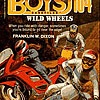This book created possibly the most popular treasure-hunt ever organized, many people will remember it gripping the nation's enthusiasm and imagination from the end of the '70s to 1982.
It took the form of a beautifully written and illustrated book launched in 1979 by the artist and author Kit Williams, and was one of the last of the ethereal, dreamy legacies of the 1960s spirit to really achieve a nationwide cult following before the Thatcher era wiped away such innocence.
Sadly, the venture did indeed ultimately fall victim to the greed and ambition that followed.
The book told a mythical story of the Moon's attempts to court the Sun, by sending to him a magnificently crafted jeweled necklace in the keeping of the Moon's trusted messenger, the Hare. Jack Hare journeys across the Earth with the precious gift, meeting with all manner of mishaps and curious people on the way. At sunset, when he comes face to face with the Sun, he finds to his dismay that he has lost the jewel en route, so stalls for time by asking the Sun a riddle, but to little avail.
The challenge for the reader was to try to find out where the hare lost the necklace by following various clues within the book. Kit Williams specially created the necklace himself, in the shape of a gold hare hung with charms and amulets of ruby, sapphire and lapis lazuli, and buried it secretly somewhere in England encased in a hare-shaped casket, witnessed by a (then) unknown trustee who was sworn to secrecy. Whosoever managed to track down it's location, got to keep it- it was worth about £50,000 at the time, although it was so splendid that I for one would certainly have thought twice before parting with it.
There followed several years of fanatical treasure-hunting on the part of literally millions of people from all over the world, who spent many hours poring over 'Masquerade' in an attempt to crack the complex and often highly convoluted clues. Thousands thought that they had cracked the code, only to be proved wrong time and time again! Several people ended up having to be rescued from cliff faces or disused mineshafts in their belief that the necklace's hiding-place lay there- the search made international news on & off for nearly 3 years, and Kit Williams himself became a household name.
However, despite his assertion that the riddle 'could be just as easily solved by a bright child of ten as by an Oxford don', the book's clues were very difficult. One of the key elements was a number-grid, which cropped up in various guises throughout the illustrations, and involved binary mathematics to convert them into different figures. In conjunction with other visual clues and oblique references to time & place that cropped up throughout the tale, these then provided map references or triangulation figures that could point to the burial site's location.
But as well as the lure of finding the treasure, many folks followed 'Masquerade' simply because it was such fun. Many of the illustrations in the book show locations in Gloucestershire, where Williams lives, including a superb aerial view of Tewkesbury.
In the end, nobody ever DID solve the puzzle, and the necklace ended up being 'discovered' by a cheat. On 24th February 1982, a seemingly innocent fellow called Ken Thomas announced his finding of the treasure buried near a stone cross in Ampthill Park, Bedfordshire, 'while letting his dog out for a wee'. However, he was never able to properly account for the methods he used to unravel the mystery, and it later emerged (after the jewel was in his possession) that he had been given covert assistance by Kit Williams' estranged girlfriend, who told him where to look as a way of getting back at her former partner. 'Ken Thomas' was in reality a shady businessman called Dugald Thompson, who used the necklace as security to finance the setting up of a computer games company. This went bust in '88, forcing him to sell the treasure to pay off his debts- it was bought by an anonymous American buyer, who had it shipped to the USA. It has never been seen since, and is now thought (sadly) to have been taken apart to make separate pieces of jewelery. Dugald Thompson has long since vanished into the obscurity he deserves.
A booklet providing the solution to the 'Masquerade' puzzle was issued in '83- for those who have never read the book, it's still worth doing so. The necklace may now be gone and the hunt for it is history, but the story and illustrations are so poetic and beautiful they are worth enjoying in their own right.










Do You Remember Masquerade?
Do You Remember Masquerade?